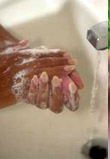
Obsessive-Compulsive Disorder
 "I couldn't do anything without rituals. They transcended every aspect of my life. Counting was big for me. When I set my alarm at night, I had to set it to a number that wouldn't add up to a "bad" number. If my sister was 33 and I was 24, I couldn't leave the TV on Channel 33 or 24. I would wash my hair three times as opposed to once because three was a good luck number and one wasn't. It took me longer to read because I'd count the lines in a paragraph. If I was writing a term paper, I couldn't have a certain number of words on a line if it added up to a bad number. I was always worried that if I didn't do something, my parents were going to die. Or I would worry about harming my parents, which was completely irrational. I couldn't wear anything that said Boston because my parents were from Boston. I couldn't write the word "death" because I was worried that something bad would happen."
"I couldn't do anything without rituals. They transcended every aspect of my life. Counting was big for me. When I set my alarm at night, I had to set it to a number that wouldn't add up to a "bad" number. If my sister was 33 and I was 24, I couldn't leave the TV on Channel 33 or 24. I would wash my hair three times as opposed to once because three was a good luck number and one wasn't. It took me longer to read because I'd count the lines in a paragraph. If I was writing a term paper, I couldn't have a certain number of words on a line if it added up to a bad number. I was always worried that if I didn't do something, my parents were going to die. Or I would worry about harming my parents, which was completely irrational. I couldn't wear anything that said Boston because my parents were from Boston. I couldn't write the word "death" because I was worried that something bad would happen."
" Getting dressed in the morning was tough because I had a routine, and if I deviated from that routine, I'd have to get dressed again. I knew the rituals didn't make sense, but I couldn't seem to overcome them until I had therapy."
Obsessive-compulsive disorder is characterized by anxious thoughts or rituals you feel you can't control. If you have OCD, as it's called, you may be plagued by persistent, unwelcome thoughts or images, or by the urgent need to engage in certain rituals.
You may be obsessed with germs or dirt, so you wash your hands over and over. You may be filled with doubt and feel the need to check things repeatedly. You might be preoccupied by thoughts of violence and fear that you will harm people close to you. You may spend long periods of time touching things or counting; you may be preoccupied by order or symmetry; you may have persistent thoughts of performing sexual acts that are repugnant to you; or you may be troubled by thoughts that are against your religious beliefs.
The disturbing thoughts or images are called obsessions, and the rituals that are performed to try to prevent or dispel them are called compulsions. There is no pleasure in carrying out the rituals you are drawn to, only temporary relief from the discomfort caused by the obsession.
A lot of healthy people can identify with having some of the symptoms of OCD, such as checking the stove several times before leaving the house. But the disorder is diagnosed only when such activities consume at least an hour a day, are very distressing, and interfere with daily life.
Most adults with this condition recognize that what they're doing is senseless, but they can't stop it. Some people, though, particularly children with OCD, may not realize that their behavior is out of the ordinary.
OCD strikes men and women in approximately equal numbers and afflicts roughly 1 in 50 people. It can appear in childhood, adolescence, or adulthood, but on the average it first shows up in the teens or early adulthood. A third of adults with OCD experienced their first symptoms as children. The course of the disease is variable - symptoms may come and go, they may ease over time, or they can grow progressively worse. Evidence suggests that OCD might run in families.
Depression or other anxiety disorders may accompany OCD. And some people with OCD have eating disorders. In addition, they may avoid situations in which they might have to confront their obsessions. Or they may try unsuccessfully to use alcohol or drugs to calm themselves. If OCD grows severe enough, it can keep someone from holding down a job or from carrying out normal responsibilities at home, but more often it doesn't develop to those extremes.
Research by NIMH-funded scientists and other investigators has led to the development of medications and behavioral treatments that can benefit people with OCD. A combination of the two treatments is often helpful for most patients. Some individuals respond best to one therapy, some to another. Two medications that have been found effective in treating OCD are clomipramine and fluoxetine. A number of others are showing promise, however, and may soon be available.
Behavioral therapy, specifically a type called exposure and response prevention, has also proven useful for treating OCD. It involves exposing the person to whatever triggers the problem and then helping him or her forego the usual ritual - for instance, having the patient touch something dirty and then not wash his hands. This therapy is often successful in patients who complete a behavioral therapy program, though results have been less favorable in some people who have both OCD and depression.
Related Links
NIMH
Information on OCD
Obsessive
Compulsive Foundation
Managed Care On-Line